
Looking for a dog that fits a relaxed lifestyle? If you prefer a calm companion, whether you live in a smaller space or just appreciate a low-energy friend, there are several breeds known for their naturally mellow and sleepy nature. While some dogs are famous for their activity levels, others are experts at taking it easy. So, if a laid-back furry friend is what you have in mind, there are definitely breeds that tend to be more on the quiet and restful side.
In this AnimalWised article, we’ll reveal the top 7 laziest dog breeds that are perfect for cuddling on the couch, napping in the sun, and keeping things mellow.
Basset Hound
The Basset Hound leads our list of laid-back dog companions. They are instantly recognizable by its appearance, short legs, elongated body, droopy eyes, and ears so long they practically sweep the floor.
Originally bred in France as scent hounds, Basset Hounds were developed to track rabbits and hares through difficult terrain. Their name derives from the French word "bas" meaning "low," a perfect description of their close-to-ground stature. While their ancestors were working dogs, today's Basset Hounds have fully embraced the laid-back lifestyle most of us can only dream about.
While they began as serious rabbit and hare hunters, today's Bassets have comfortably transitioned to family life. Their exceptional tracking abilities remain intact, though, with approximately 220 million scent receptors (compared to our measly 5 million), their nose still drives much of their behavior.
Their relaxed pace comes naturally, they were bred to track methodically rather than chase quickly. This makes them excellent apartment dwellers and perfect companions for those who prefer movies marathons to actual marathons.
While they make excellent companions, potential owners should note their independent streak. Basset Hounds can display stubborn behavior during training sessions, requiring consistent, patient guidance. Their laid-back nature isn't laziness, it's simply part of their breeding as methodical scent trackers rather than high-energy sprinters.
Despite their reputation for laziness, Basset Hounds still require regular, moderate exercise to maintain health and prevent obesity, which can strain their distinctive long back and short legs. Daily walks, and occasional play sessions typically satisfy their activity requirements.
Can't tell a Basset Hound from a Beagle? Our simple guide shows you how to spot the differences.

Mastiff
Following our laid-back Basset Hound is the imposing yet surprisingly lazy Mastiff family. The term "mastiff" encompasses several breeds sharing key characteristics. Most notable is their impressive size, often weighing between 120-230+ pounds, supported by a powerful, muscular build with substantial bone structure.
Their distinctive broad, rounded head and strong jaw give them a scary appearance that historically made them excellent guardians. Despite their looks, they typically display a calm temperament that aligns perfectly with their low-energy lifestyle.
Their ancient lineage dates back thousands of years, with mastiff-type dogs appearing in artifacts from early civilizations across Europe and Asia. Historically, these powerful dogs served as guardians against predators like wolves, protected livestock, defended property, and even participated in warfare and combat sports.
Despite their warrior history, modern mastiffs are famously low-energy. This isn't accidental, their massive size makes conservation of energy essential. Most adult mastiffs are content with moderate daily walks and plenty of rest. Their typical behavior involves finding a comfortable spot and monitoring their surroundings with minimal movement.
This laid-back nature makes them suitable for apartment living despite their size. However, their substantial weight means quality joint support is essential for their comfort.
"Did you know there are big differences between Mastiff breeds from different countries? Explore our comparison of these super-sized sleepy dogs.
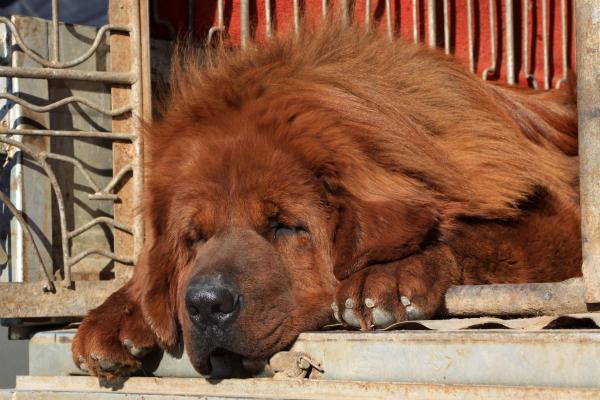
Pug
After exploring the massive Mastiffs, we turn to a much smaller but equally relaxed canine: the Pug. These compact companions pack a lot of personality into a small package, typically weighing under 18 pounds (8 kg).
Pugs belong to the brachycephalic dog breeds, characterized by their shortened facial structure. Their round head, large expressive eyes, flat nose, and distinctive wrinkles give them an almost human-like expressiveness that many find irresistible.
However, this adorable appearance comes with significant health considerations. Their compressed facial anatomy frequently leads to Brachycephalic Obstructive Airway Syndrome (BOAS), causing breathing difficulties, especially in hot weather or during exercise. These respiratory challenges contribute to their low-energy demeanor and preference for relaxation.
Pugs have an impressive lineage dating back over 2,000 years to ancient China, where they were developed specifically as companion animals for Chinese royalty and nobility. Unlike many breeds with working backgrounds, Pugs have always been bred purely for companionship, essentially professional loungers from the start.
Their status as luxury pets spread through Asia and eventually to Europe in the 16th century, where they became favorites in various royal courts. This long history as companion animals has refined their people-oriented temperament through countless generations.
While many small breeds tend toward high energy, Pugs break this mold with their relaxed approach to life. Their moderate exercise needs typically consist of short walks and brief play sessions, making them excellent apartment dwellers.
What truly sets Pugs apart is their extraordinary affection level. They form intensely close bonds with their owners and often seek physical contact, earning them the nickname "velcro dogs." This desire for closeness makes them champion cuddlers who will happily spend hours snuggled against their favorite humans.
Pugs are known for their unique breathing sounds. Learn what that distinctive honking noise means and when to be concerned in our companion article.
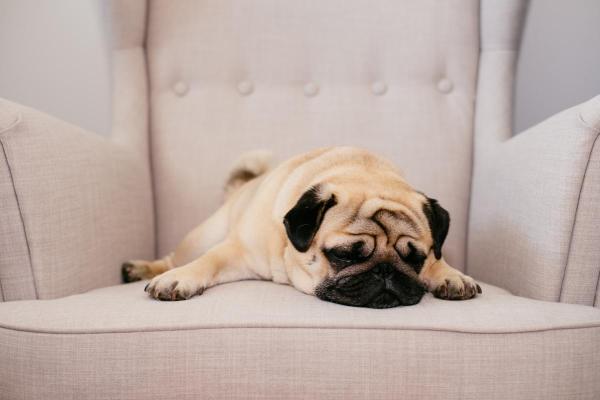
Shih Tzu
Continuing our journey through the world of lazy dog breeds, we arrive at the regal Shih Tzu. Weighing between 9-16 pounds (4-7 kg), Shih Tzus are known by their luxurious double coat that grows continuously like human hair, rather than shedding seasonally like most dogs.
The name "Shih Tzu" translates to "Lion Dog" in Mandarin, reflecting both their appearance and their esteemed position in Chinese culture. Their history traces back over a thousand years to imperial China, where they served exclusively as companion dogs to emperors and royal family members. Unlike many ancient breeds developed for working purposes, Shih Tzus were bred specifically for companionship and ornamental value within palace walls.
This aristocratic heritage likely contributed to their calm temperament, palace dogs needed to be quiet, composed, and comfortable spending long hours in relaxed companionship rather than engaging in physical labor or protection.
True to their royal breeding, Shih Tzus exhibit a calm demeanor that perfectly suits a low-energy lifestyle. They typically require minimal exercise, with short daily walks and occasional play sessions satisfying their physical needs. This makes them excellent apartment dwellers and companions for less active owners.
Despite their relaxed energy level, Shih Tzus are deeply social dogs who form strong bonds with their families. They generally show friendly dispositions toward strangers, children, and other pets, making them adaptable to various household configurations. Their alert nature means they'll often announce visitors, but they lack the aggressive tendencies that would make them effective guard dogs.
Love those luxurious Shih Tzu locks? Learn how to keep your sleepy companion's coat looking its best in our complete grooming guide.
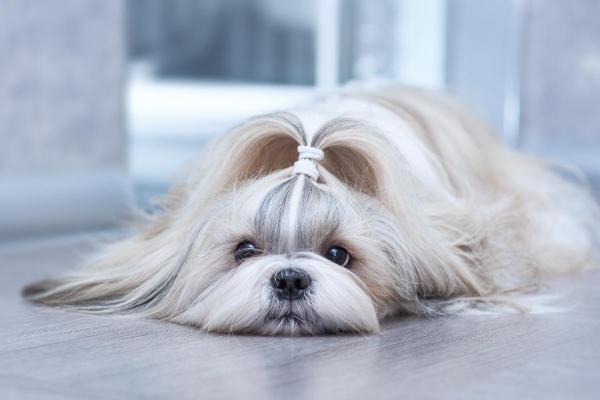
Saint Bernard
After exploring the small Shih Tzu, we move to the opposite end of the size spectrum with the impressive Saint Bernard. These giants are among the largest dog breeds, with males typically weighing between 140-180 pounds (63-82 kg), though some exceptional dogs have exceeded 200 pounds (90 kg).
Saint Bernards catch the eye with their massive build. Their thick double coat features the classic red and white or brown and white pattern that made the fictional Beethoven instantly recognizable to movie audiences. Their broad head, expressive eyes, and somewhat droopy expression create a gentle, almost soulful look that contrasts with their tremendous strength.
They were developed in the Swiss and Italian Alps by monks at the Saint Bernard Hospice, a remote mountain pass sanctuary established in the 11th century. The monks initially used local farm dogs as companions and guardians, but over generations, these dogs evolved into the breed we recognize today.
While movies and stories often show them as rescue dogs with brandy barrels around their necks, their actual historical role was more varied. They did help in mountain rescues, using their excellent scent abilities to locate travelers lost in avalanches or blizzards. However, they also pulled carts and transported supplies through mountain terrain, while serving as watchdogs and companions for the monastery.
Despite their working background, modern Saint Bernards prefer a relaxed lifestyle. Their enormous size naturally leads them toward energy conservation, making them surprisingly low-maintenance for exercise. Most are happy with moderate daily walks and short play sessions, after which they'll spend hours sleeping peacefully.
This relaxed temperament is partly necessary. Their large bodies generate considerable heat and don't cool efficiently, making extended activity difficult, especially in warm weather. Their tendency to rest increases as they mature, with adult Saint Bernards often finding the coolest floor spot for long naps.
Wondering how to properly feed these giant lazy dogs? Our guide on St. Bernard nutrition explains exactly how much these gentle giants should eat.
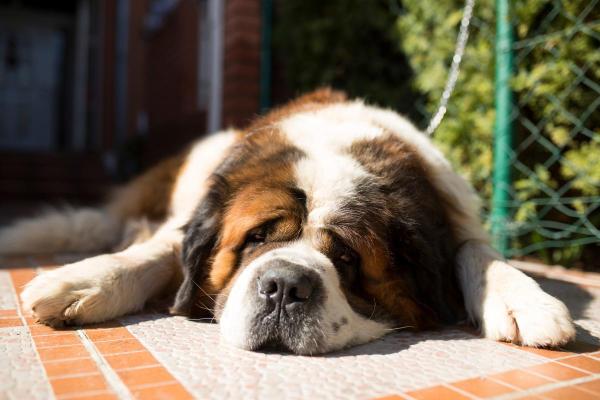
Greyhound
Moving from the massive Saint Bernard, we shift to the athletic Greyhound family. These dogs challenge common assumptions about high-energy breeds, combining speed with an unexpected talent for relaxation.
The term "greyhound" applies to several breeds sharing a distinctive body structure built for speed. Their streamlined silhouette features a deep chest, dramatically tucked abdomen, long legs, and narrow head with an elongated snout. This specialized anatomy creates the perfect natural sprinting machine, allowing some greyhounds to reach speeds up to 45 mph (72 km/h), making them the fastest dog breeds on earth.
Their lean, muscular build typically includes minimal body fat, giving them their characteristic sleek appearance.
What surprises many first-time greyhound owners is the contrast between these dogs' athletic capabilities and their home behavior. While greyhounds need regular opportunities to run at high speeds, these exercise sessions are typically brief. A few sprinting sessions per week in a secure area often satisfy their physical needs.
Once their exercise requirements are met, greyhounds transform into some of the most relaxed house dogs available. They excel at conserving energy, often spending 16-20 hours daily sleeping or resting. This "couch potato" tendency makes them unexpectedly suitable for apartments and smaller homes despite their size.
These dogs bring several advantages to home life. Their short coats (in most varieties) shed minimally compared to many breeds. They're typically clean, odor-free, and naturally well-mannered indoors. Their sensitivity to temperature means they appreciate soft bedding and blankets for warmth during cooler weather. Many adapt well to wearing sweaters or coats during winter walks.
Did you know that Greyhounds' low body fat can make them prone to shaking? Find out why these lazy speedsters tremble and how to help them in our companion guide.
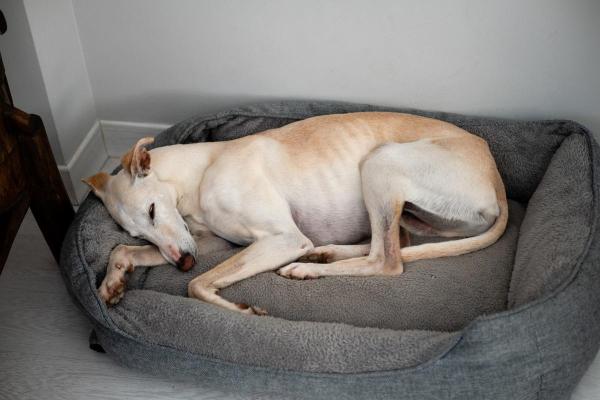
Chow chow
We complete our list with the Chow Chow. What really makes them stand out is that resemblance to a lion. That iconic look comes from their thick double coat, forming a mane-like ruff around their head and shoulders.
Their most unique feature is their blue-black tongue, one of only two dog breeds (along with the Chinese Shar-Pei) to display this trait. Explore the genetics and facts behind this unique characteristic in our in-depth article.
Chow Chows are among the world's oldest dog breeds, with a history dating back at least 2,000 years in China. Their versatility led to multiple uses throughout history. They pulled carts, hunted game, guarded property, and even served as a food source during times of extreme hardship. Some were also bred for their thick fur, which was used for clothing.
Unlike the overtly affectionate nature of Pugs or Basset Hounds, Chows exhibit a reserved, almost cat-like independence. They're typically devoted to their immediate family but often indifferent to strangers.
Their strong-willed temperament requires consistent, patient training from an early age. This independent streak, combined with their physical strength, makes them better suited for experienced dog owners rather than first-time pet parents. Early socialization is essential to develop good behavior around children and other pets.
Their low energy level makes them excellent house dogs who typically require only moderate daily exercise. Once their minimal activity needs are met, they excel at finding a comfortable spot for extended napping sessions.
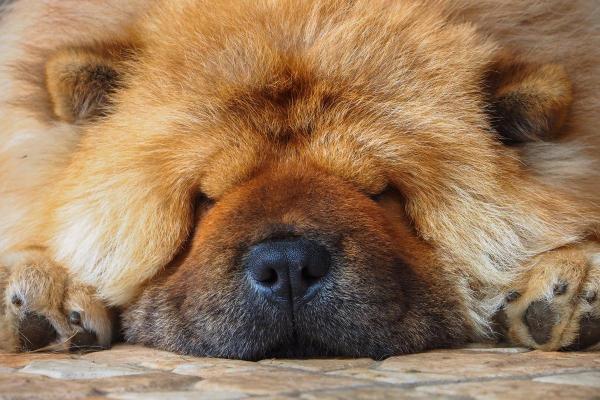
If you want to read similar articles to Dog Breeds That Sleep a Lot, we recommend you visit our Comparisons category.
- Fogle, B. (1995). The Encyclopedia of the Dog , London: Dorling Kindersley.
- Veterinary Portal. (2024). 20% of dogs suffer from some type of sleep disorder at some point in their lives . Available at https://www.portalveterinaria.com/animales-de-compania/actualidad/43224/el-20-por-ciento-de-los-perros-sufre-algun-tipo-de-trastorno-del-sueno-en-algun-momento-de-su-vida.html